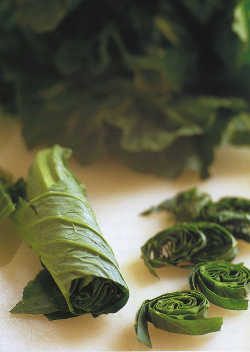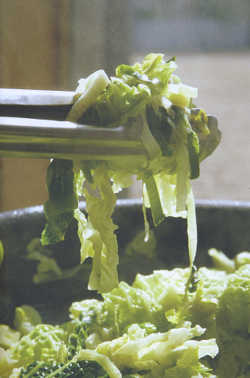In Season - Spring Cabbage
 One of the new the season’s first crops, spring cabbage was a favourite vegetable before the days of all-year everything as it was such a welcome change after the heavy winter vegetables. It may not be as popular as it used to be, but it certainly deserves a special place in the kitchen as it’s a versatile and healthy vegetable and - being rich in vitamin C, folic acid and dietary fibre - just what’s needed to boost the system as we go into summer.
One of the new the season’s first crops, spring cabbage was a favourite vegetable before the days of all-year everything as it was such a welcome change after the heavy winter vegetables. It may not be as popular as it used to be, but it certainly deserves a special place in the kitchen as it’s a versatile and healthy vegetable and - being rich in vitamin C, folic acid and dietary fibre - just what’s needed to boost the system as we go into summer.
The special features of this leafy brassica are that central leaves form only a loose pointed head, or none at all, and it’s often known simply as ‘spring greens’, a term also used more broadly to include thinnings and trimmings leaves from other types of brassica, including curly kale, cauliflower, broccoli and brussels sprouts.
The loose formation and exposure to light produces dark green leaves and, although they can be strongly flavoured, they are easy to cook and work well with a surprising number of other foods.
If you have an allotment or a large garden, they’re well worth growing in the space left after early potatoes have been lifted and will give fresh greens throughout the ‘hungry gap, from early April to June when summer vegetables come on stream.
Cooking spring greens is easy. Simply slice the leaves and steam or cook quickly in a little boiling water, then drain well and finish with pepper and a knob of butter, or add as the last ingredient in a stirfry. They are lovely with the addition of some gently fried onion and bacon, and mix well with other vegetables.
Leafy greens complement a wide range of foods, including robustly flavoured fish like salmon, the only rule is that they must be cooked quickly and not overcooked.
RECIPE SUGGESTION from River Cottage Everyday by Hugh Fearnely-Whittingstall (Bloomsbury):
“I've never had much trouble eating my greens and I hope these recipes will ensure you don't either. The golden rule with almost any brassica or beet leaf, whether it's the leaf or stem, or unformed flower (as with broccoli and caulis) is to keep the cooking time short.
Stick to this, and pair your lightly done greens with a smidgeon of something rich and lubricating, and/or textured and savoury - most obviously a knob of butter (garlicky, if you like), but also a little crisp bacon, a just-cooked egg, a few toasted seeds... you get the idea.”
 Leeks with greens
Leeks with greens
Soft, buttery, wilted leeks bring a lovely sweetness to any kind of lightly cooked cabbage or greens. This simple preparation is one I turn to frequently, both at home and when cooking at River Cottage: it's so easy to throw together, can be made with different seasonal greens throughout most of the year and works as a side dish to everything from a bit of grilled fish to a full-on Sunday roast.
Serves 4
About 500g leeks
A knob of unsalted butter
1 Savoy or other green cabbage, 2 heads of spring greens, or a few bunches of curly kale
Sea salt and freshly
ground black pepper
Trim the leeks, slice them finely (maximum 5mm) and give them a good rinse to get rid of any grit. Heat the butter in a large frying pan or wide saucepan and add the leeks with a pinch of salt. Let them cook gently for 5-6 minutes, stirring or shaking the pan occasionally, until wilted and tender.
Meanwhile, trim and coarsely shred the cabbage, greens or kale. Cook lightly - in either a steamer or a large saucepan of salted water - for 3-4 minutes, until wilted and tender but not too soft. Remove from the heat immediately, drain well and let the excess moisturesteam off for a minute or so.
Then add to the pan of buttery leeks,along with some more seasoning, and stir over a low heat for about a minute until thoroughly combined. Serve straight away.
In theory you can use any leftovers for bubble and squeak... but in practice there rarely are any.





There are currently no comments
Leave a comment
Not a member? Register for your free membership now!
Or leave a comment by logging in with: